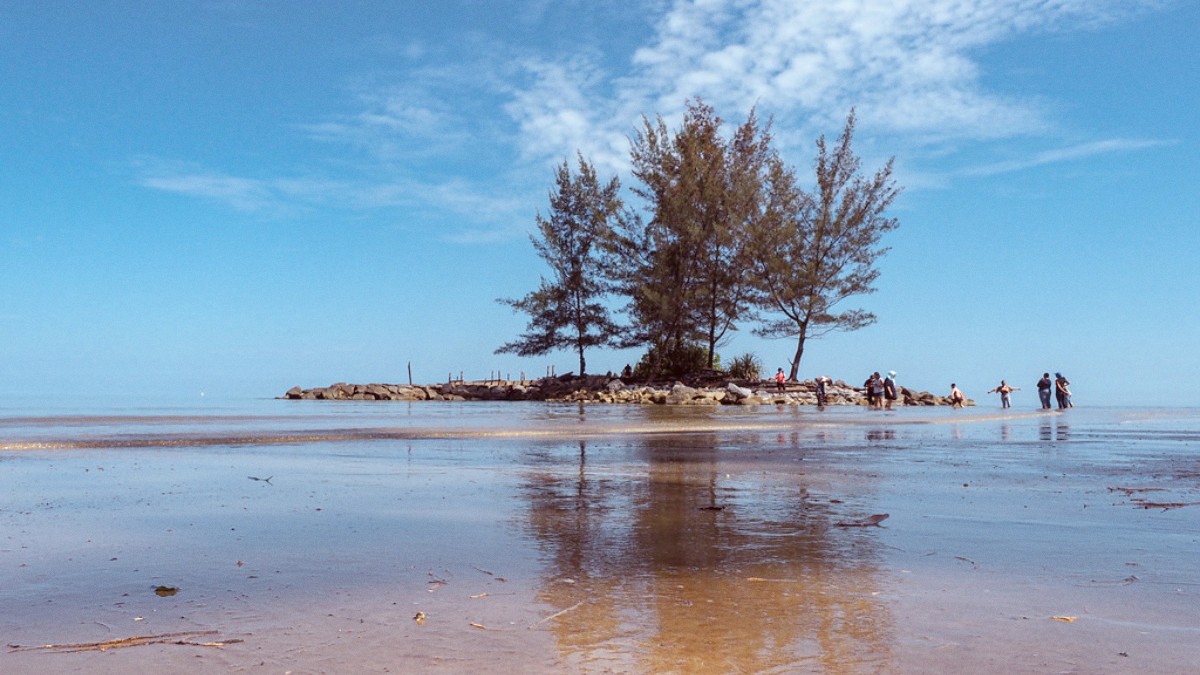
Malaysian Borneo Sarawak, Malaysia
Miri experiences an equatorial climate. This means high temperatures, high humidity, and plenty of rain every month. Daily temperatures stay between 23°C (73°F) and 32°C (90°F) throughout the year. Fluctuations are minimal, so expect warm weather daily.
Rain is heavy, with over 2500 mm (98 inches) falling annually. Miri has two main monsoon seasons: Northeast Monsoon (Wet Season) from October/November to February/March, bringing heavier rain. Southwest Monsoon (Dry Season) from April to September, with less intense and frequent rainfall. Many consider this the preferred time for tourism. Expect high humidity levels, typically between 80% and 90%.
Miri does not experience hurricanes. Heavy rainfall can cause localized flooding in low-lying urban areas. Mudslides are a risk in hilly, rural areas after prolonged heavy rain. Always check local weather forecasts before you plan excursions, especially into the interior. Haze from regional forest fires can impact air quality, usually between June and September during the dry season. Monitor the Air Pollutant Index (API) during this period.
November - February
Lowest prices for hotels and tours; fewer crowds; lush, green rainforests from frequent rain.
Heavy rainfall disrupts outdoor plans; rough seas or poor visibility for water activities; rural roads may become muddy.
March, October
Fewer crowds; prices may drop slightly; generally good weather.
Weather less predictable; rain showers might last longer.
April - September
Less rain and more sunshine ideal for outdoor activities; diving visibility typically at its best.
More tourists; higher prices for accommodation and tours; book ahead.
The drier months from April to September work best. This avoids slippery trails and higher water levels inside the caves.
Drier months better trail conditions. You can trek rainforests year-round, but pack appropriate gear for wet trails.
April to September (drier, fewer slippery trails).
Drier months for better trail conditions.
April to September (excellent visibility, calmer seas).
High season (April-Sept) for most outdoor experiences.
Low season (Nov-Feb) for lower prices and fewer crowds.
Malaysia has distinct needs based on your nationality.
Malaysia offers various entry methods depending on your citizenship. Always confirm the specific duration allowed for your passport.
Have these documents ready for entry. Immigration officers often ask for proof of onward travel and funds.
Always verify visa needs for your nationality close to your travel date, as regulations change. Visit the official Malaysian Immigration Department website for the most current information.
Set your budget for a Miri trip to make certain a comfortable journey. Costs vary based on your travel style, from budget-conscious to luxury.
The official currency of Malaysia is the Malaysian Ringgit (MYR), often displayed as RM. Exchange rates fluctuate daily. In late 2023/early 2024, approximately 1 USD equaled 4.7 MYR. Always check current rates before your trip.
Miri city has many ATMs that accept major international cards like Visa and Mastercard. Inform your bank of your travel plans to avoid card blocks. Check with your bank regarding foreign transaction fees. Money changers usually offer slightly better rates than banks. Avoid airport exchanges unless urgent.
Daily spending of RM 120 - 255 for affordable lodging, local food, public transit, and minimal attractions.
Hostels/Guesthouses: RM 30-80 (dorm), RM 50-120 (private basic).
Street Food: RM 5-15 per dish.
Daily spending of RM 250 - 700 for comfortable hotels, diverse dining, ride-sharing, and guided tours.
Mid-range Hotels: RM 100-300 per night.
Grab rides: RM 5-20 per ride (within city).
Daily spending of RM 700+ for premium accommodations, fine dining, private transport, and tailored experiences.
Luxury Hotels/Resorts: RM 300-800+ per night.
Fine Dining: RM 50-150+ per person.
| Category | Budget | Mid-Range | Luxury |
|---|---|---|---|
| Accommodations | RM 30-120 | RM 100-300 | RM 300-800+ |
| Meals | RM 5-15 (Street food) | RM 15-40 (Local restaurant) | RM 50-150+ (Fine dining) |
| Transportation | RM 1-5 (Local bus) | RM 5-20 (Grab) | RM 100-250 (Car rental) |
| Attractions | RM 20-30 (Park entrance) | RM 100-500+ (Guided tours) | Higher for specialized tours |
Grasp potential risks and how to manage them.
Discuss vaccinations with a travel health professional before your trip.
A certificate is a must if arriving from or transiting through risk countries. Carry it.
Routine vaccinations, Hepatitis A/B, Typhoid. Rabies (for extensive outdoors/animal contact), Japanese Encephalitis (for prolonged rural stays).
Prevention is in Miri's tropical climate.
Mosquito-borne illnesses like Dengue Fever are present; use Insect repellent with DEET or picaridin, wear long sleeves. Malaria risk is low in Miri city, but consider anti-malarials for deep jungle trips.
Food and Waterborne Illnesses ("Traveler's diarrhea") happen. Drink bottled or boiled water. Avoid ice from tap water. Eat hot, freshly cooked food. Peel fruits yourself. Stay hydrated to avoid heat exhaustion/stroke.
The equatorial sun is strong. Use High-SPF sunscreen and wear a Wide-brimmed hat. Clean cuts promptly.
Miri Hospital (public) and Columbia Asia Hospital Miri (private) are available. Private options typically offer higher standards.
Numerous private clinics handle minor ailments. Well-stocked pharmacies offer common medications.
Generally reliable. Dial 999 for Police/Ambulance/Fire. Tourist Police Hotline: 03-2932 9999.
Miri is a generally safe city for tourists, but awareness remains important.
Tap water in Miri typically stands unsafe for direct consumption.
Consume only bottled water (check seals) or boiled water (e.g., from hotel kettles).
Consider a Portable water filter or Purification tablets for remote areas.
Hawker center hygiene generally good. Choose stalls with high customer turnover and fresh cooking.